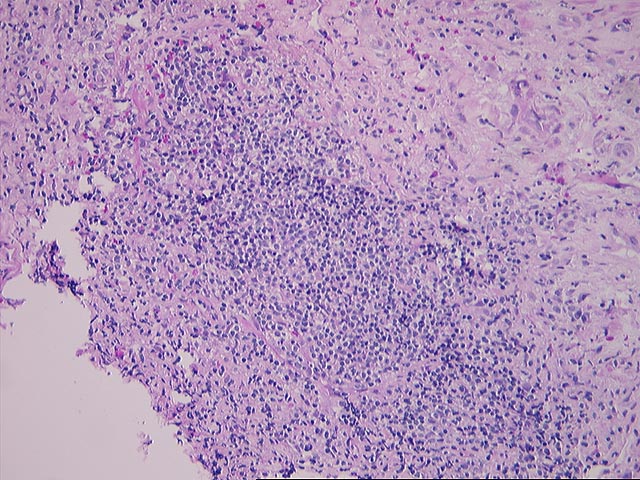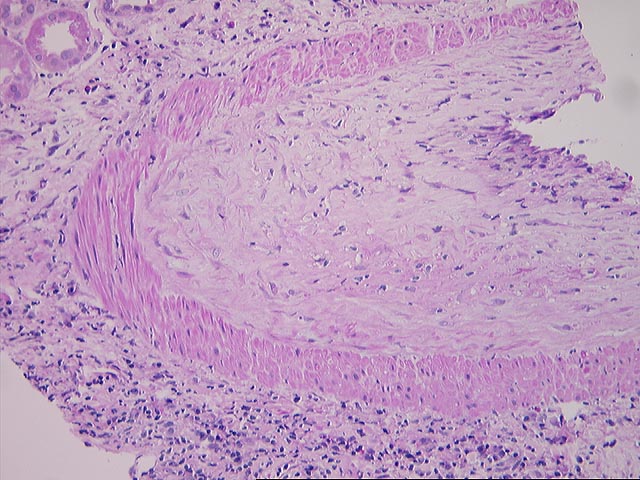PART 2:
ALLOGRAFT KIDNEY, NEEDLE BIOPSY-
- CHRONIC REJECTION WITH MODERATE TO SEVERE INTERSTITIAL FIBROSIS AND OBLITERATIVE ARTERIOPATHY (cg1,ci2-3,ct3,cv3,ah2).
- ACUTE REJECTION, MILD TO MODERATE, BANFF GRADE 1-2 (g0,i2-3,t3,v0-1).
- FOCAL VASCULAR THROMBOSIS.
- FOCAL LYMPHOID HYPERPLASIA; IN-SITU HYBRIDIZATION FOR EPSTEIN-BARR VIRUS IS NEGATIVE.
Comment:
Several foci of intense lymphoid hyperplasia are noted
in the allograft nephrectomy, and one such focus is also found in the needle
biopsy. These are felt to be a manifestation of allogeneic immune activation,
since the degree of lymphoid atypia is within the spectrum of reactive
proliferation, and there is no evidence for serpiginious necrosis.
Furthermore, EBER in-situ hybridization for Epstein-Barr virus is negative.
The clinical suspicion of post-transplant lymphoproliferative disease cannot
be substantiated.
Previous Biopsies on this Patient:
None
TPIS Related Resources:
Kidney
Transplant Topics
Gross Description - Case 6
The specimen consists of nineteen (19) consult slides: Part 1 (12 slides, 8 unstained), and Part 2 (7 slides, 3 unstained). No surgical pathology report is received with the specimen.Microscopic Description - Case 6
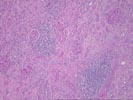
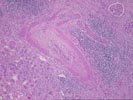
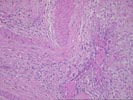
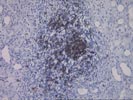
PART 1
| 1. Glomerulosclerosis | ||||
|---|---|---|---|---|
| 1.1 Number of glomeruli | (Multiple) | |||
| 1.2 Number globally sclerotic | ( ) | |||
| 1.3 Segmental sclerosis | ( )YES | ( )NO | ||
| 2. Glomerulitis | (X)0 | ( )1 | ( )2 | ( )3 |
| 3. Interstitial inflammation | ( )0 | ( )1 | ( )2 | (X)3 |
| 4. Intimal arteritis | ( )0 | ( )1 | (X)2 | ( )3 |
| 5. Tubulitis | ( )0 | ( )1 | ( )2 | (X)3 |
| 6. Arteriolar hyalin | ( )0 | ( )1 | (X)2 | ( )3 |
| 7. Chronic glomerular change | ( )0 | (X)1 | ( )2 | ( )3 |
| 8. Interstitial fibrosis | ( )0 | ( )1 | ( )2 | (X)3 |
| 9. Tubular atrophy | ( )0 | ( )1 | ( )2 | (X)3 |
| 10. Vascular intimal sclerosis | ( )0 | ( )1 | ( )2 | (X)3 |
| 11. Other Findings | L26 positive B-cells present within the reactive lymphoid nodules. | |||
| 12. Diagnostic categories | ||||
| 12.1 Acute rejection (KDAR2) [g,i,t,v codes]: |
| |||
| 12.2 Chronic allograft nephropathy (KDCR3) [cg,ci,ct,cv codes]: |
| |||
| 12.3 Drug-associated changes (KDDR): | ( ) | |||
| 12.4 Acute tubular necrosis (KDAT): | ( ) | |||
| 12.5 Donor diseases (KDDO): | ( ) | |||
| 12.3 Other: |
|
| ||
PART 2
The needle biopsy shows findings essentially similar to
the nephrectomy, but the degree of interstitial inflammation, tubulitis and
intimal arteritis are less prominent. This difference presumably reflects a
reduction in immunosuppression prior to nephrectomy.
Please mail comments, corrections or suggestions to the TPIS administration at the UPMC.
